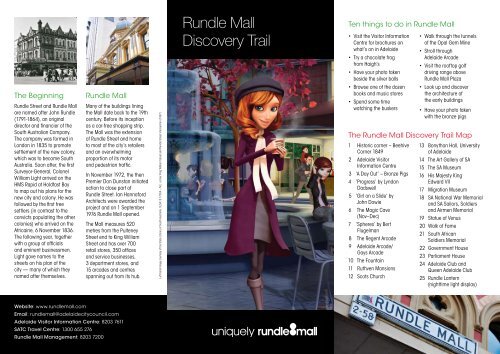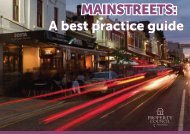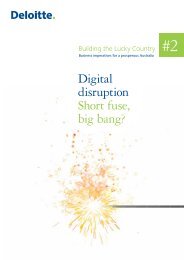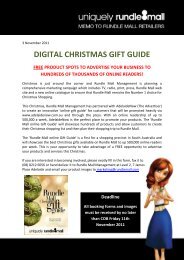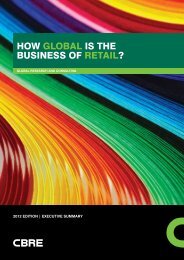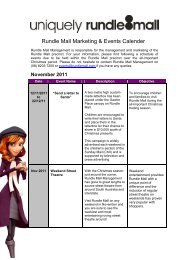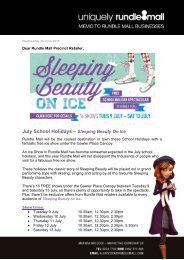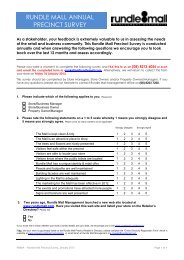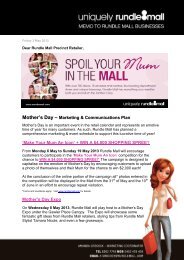Create successful ePaper yourself
Turn your PDF publications into a flip-book with our unique Google optimized e-Paper software.
The Beginning<strong>Rundle</strong> Street and <strong>Rundle</strong> <strong>Mall</strong>are named after John <strong>Rundle</strong>(1791-1864), an originaldirector and financier of theSouth Australian Company.The company was formed inLondon in 1835 to promotesettlement of the new colony,which was to become SouthAustralia. Soon after, the firstSurveyor-General, ColonelWilliam Light arrived on theHMS Rapid at Holdfast Bayto map out his plans for thenew city and colony. He wasfollowed by the first freesettlers (in contrast to theconvicts populating the othercolonies) who arrived on theAfricaine, 6 November 1836.The following year, togetherwith a group of officialsand eminent businessmen,Light gave names to thestreets on his plan of thecity — many of which theynamed after themselves.<strong>Rundle</strong> <strong>Mall</strong>Many of the buildings liningthe <strong>Mall</strong> date back to the 19thcentury. Before its inceptionas a car-free shopping strip.The <strong>Mall</strong> was the extensionof <strong>Rundle</strong> Street and hometo most of the city’s retailersand an overwhelmingproportion of its motorand pedestrian traffic.In November 1972, the thenPremier Don Dunstan initiatedaction to close part of<strong>Rundle</strong> Street. Ian HannafordArchitects were awarded theproject and on 1 September1976 <strong>Rundle</strong> <strong>Mall</strong> opened.The <strong>Mall</strong> measures 520metres from the PulteneyStreet end to King WilliamStreet and has over 700retail stores, 350 officesand service businesses,3 department stores, and15 arcades and centresspanning out from its hub.Left hand image courtesy of the State Library of South Australia. SLSA: B 17064 – N.E. corner King William Street and <strong>Rundle</strong> Street intersection (1967)<strong>Rundle</strong> <strong>Mall</strong><strong>Discovery</strong> <strong>Trail</strong>Ten things to do in <strong>Rundle</strong> <strong>Mall</strong>• Visit the Visitor InformationCentre for brochures onwhat’s on in Adelaide• Try a chocolate frogfrom Haigh’s• Have your photo takenbeside the silver balls• Browse one of the dozenbooks and music stores• Spend some timewatching the buskers123456789101112Historic corner – BeehiveCorner 1849Adelaide VisitorInformation Centre‘A Day Out’ – Bronze Pigs‘Progress’ by LyndonDadswell‘Girl on a Slide’ byJohn DowieThe Magic Cave(Nov–Dec)‘Spheres’ by BertFlugelmanThe Regent ArcadeAdelaide Arcade/Gays ArcadeThe FountainRuthven MansionsScots Church• Walk through the tunnelsof the Opal Gem Mine• Stroll throughAdelaide Arcade• Visit the rooftop golfdriving range above<strong>Rundle</strong> <strong>Mall</strong> Plaza• Look up and discoverthe architecture ofthe early buildings• Have your photo takenwith the bronze pigsThe <strong>Rundle</strong> <strong>Mall</strong> <strong>Discovery</strong> <strong>Trail</strong> Map13 Bonython Hall, Universityof Adelaide14151617The Art Gallery of SAThe SA MuseumHis Majesty KingEdward VIIMigration Museum18 SA National War Memorialand SA Sailors, Soldiersand Airmen Memorial19 Statue of Venus20 Walk of Fame21 South AfricanSoldiers Memorial22 Government House23 Parliament House24 Adelaide Club andQueen Adelaide Club25 <strong>Rundle</strong> Lantern(nighttime light display)Website: www.rundlemall.comEmail: rundlemall@adelaidecitycouncil.comAdelaide Visitor Information Centre: 8203 7611SATC Travel Centre: 1300 655 276<strong>Rundle</strong> <strong>Mall</strong> Management: 8203 7200
FRANCIS STREETLINDES LANECHARLES STREETCHARLES STREET1722191816151413212023K I N G W I L L I A MS T R E E TH P F1H P F24H P F2SOUTHERN CROSS ARCADETHE MYER CENTREH P FJAMES PLACE24STEPHENS PLACECITY CROSS3RUNDLE MALL PLAZAG A W L E R P L A C EG A W L E R P L A C EH P F4RUNDLE ARCADEDA COSTA ARCADEN O R T H T E R R A C EWOOLWORTHSADELAIDE CENTRAL PLAZA576H P F8THE REGENTAUSTIN STREET TWIN STREETH P FCHARLES STREET PLAZAADELAIDE ARCADE910GAYS ARCADERENAISSANCE TOWERRENAISSANCE ARCADETWIN PLAZA ARCADECITI CENTRE ARCADEPLAYSPACE1211H P FS T R E E TP U L T E N E YH P F25H P FH P FRUNDLE LANTERNG R E N F E L LS T R E E TH PH Car Parking F PInformationFToiletsH P FH P F
1 2 3 4 5 61 Historic corner — Beehive CornerThe intersection of Hindley Street, King William Streetand <strong>Rundle</strong> <strong>Mall</strong> is rich with history. The original“Beehive” corner was owned by John <strong>Rundle</strong> in 1849.The present day Beehive Corner with its gold beewas built 1895-97 in a Gothic Revival style generallyreserved for churches and their associated buildings.Adelaide’s first electric street lighting was installedin October 1895 at the intersection of Hindley Street,King William Street and <strong>Rundle</strong> Street. During theFederation Royal Visit in 1901, seats on a grandstanderected on the corner sold for ten shillings each.This was because the royal couple —later to becrowned King George V and Queen Mary— wouldpass by them not once, but three times!2 Adelaide Visitor Information CentreThe Visitor Information Centre provides visitors with anexcellent range of tourism information on Adelaide andSouth Australia, including brochures, maps and eventguides. Come and visit the friendly volunteers who willmake your stay in Adelaide a wonderful experience.Monday to Thursday 9am – 5pmFriday9am – 8pmSaturday10am – 3pmSunday11am – 4pmPublic Holidays 11am – 3pm(closed on Christmas Day and Good Friday).For a free introduction walk to some of Adelaide’s keypoints of interest, the First Steps orientation walk leavesat 9.30am, Monday to Friday from the Adelaide VisitorInformation Centre (excluding Public Holidays).3 ‘A Day Out’ — Bronze PigsCommissioned by the Adelaide City Council, the bronzepigs by Marguerite Derricourt were officially unveiled bythe Lord Mayor, Dr Jane Lomax-Smith on 3 July 1999.A call for suggestions from the public resulted in each ofthe four pigs being named. They are: Truffles (standing),Oliver (at the bin), Horatio (sitting) and Augusta (trotting).4 ‘Progress’ by Lyndon DadswellRepresenting the spirit of progress, this neo-cubistwelded copper wall sculpture was created in 1959 andinstalled on the front of the then newly constructed DavidJones department store in 1963. The artist, Dadswell,studied firstly with Julian Ashton in Sydney and thenat the Royal Academy, London. His other public worksinclude the relief panels for Melbourne’s Shrine ofRemembrance and the King George Memorial in Sydneywhich generated much public controversy in 1945.5 ‘Girl on a Slide’ by John DowieInstalled in 1977 in the new mall, this sculpture wascreated as a ‘discovery piece’, something that wouldn’tbe visible from a distance, but would be discovered byaccident. It was donated to the City of Adelaide by thenow closed John Martins department store. Dowie isone of South Australia’s most respected sculptors andhis works appear all over Adelaide, from the fountain inVictoria Square to the Richardson Gates at Adelaide Oval.6 The Magic Cave (November–December only)If you’re in Adelaide in late November or December,stop in at The Magic Cave in David Jonesdepartment store to see Father Christmas and ahost of magical elves and fairy tale characters.This Adelaide icon began its association with JohnMartins, another department store, in 1896. The MagicCave opened in their basement as a place that peoplecould escape December’s stifling heat. The walls werecreated with crumpled zinc linings from packing cases.Unfortunately, the store burnt down in 1901 and it wasn’tuntil 1905 that the people of Adelaide again had asummer retreat. The new Magic Cave was worth the waithaving a series of caves and grottoes, waterfalls and fishponds. Over the years The Magic Cave came to represent
78 9 10 11 12 13Christmas and the jolly man himself. In 1933, Sir EdwardHayward, one of the owners of John Martins, decidedthat the people of Adelaide needed a morale boost afterthe Depression years. So he created Adelaide’s worldfamous Christmas Pageant, a colourful parade leadingFather Christmas to his Adelaide home at The Magic Cave.It’s now an annual event televised around the world.7 ‘Spheres’ by Bert FlugelmanFondly known by locals as the ‘<strong>Mall</strong>’s Balls’ or ‘Silver Balls’,these enormous spheres are the work of Bert Flugelman,an artist renowned for his imposing public art. Eachsphere measures 2.15m in diameter and is constructedfrom polished stainless steel. The sculpture wascommissioned by the Adelaide City Council for the newlycreated <strong>Mall</strong> in 1977 and was donated by the HindmarshBuilding Society to mark the society’s centenary.8 The Regent ArcadeThe Regent Theatre opened in 1928 and was consideredthe most luxurious theatre in the country. The orchestrapit could accommodate a full size orchestra. In 1930a Wurlitzer organ was installed. In 1967 the buildingwas modified to include some food and fashionshops. The cinemas were removed in 2006.9 Adelaide Arcade/Gays ArcadeAdelaide Arcade and the adjoining Gays Arcade werecompleted in 1885. The facades of the AdelaideArcade are Italianate revival in style and when it wasbuilt it was considered ‘most modern’. Not only didit have large windows to each shopfront and roofskylights, but it was also the first retail establishmentin Australia to have electric lights. Although the lowerfloor of the arcades has changed in part over the years,the upper floor remains true to its original style.There are rumoured to be at least six ghosts that callthe arcade home. The most well-known is Francis “Fred”Cluney, a caretaker who died in 1887 after falling into thegenerator that powered the lights. Although the generatorwas downstairs, he apparently haunts the roof space.10 The FountainCast in the late 1800s, the fountain was the smaller oftwo originally erected in front of the Jubilee ExhibitionBuilding that stood on North Terrace opposite PulteneyStreet. It was handed over by the State Governmentto the City Council in 1908. It stood for many years atthe junction of Gawler Place, however with the recentupgrading of the <strong>Mall</strong> it was moved to its current positionand painstakingly repainted in colours of the Victorian era.11 Ruthven MansionsBuilt in two stages (1911-12 and 1914), the RuthvenMansions was the city’s first apartment building with allthe “mod cons”, including electric lighting and mechanicalventilation. After falling into disrepair, it was saved fromdemolition and renovated in the late 1970s into today’sapartments and shopping arcade. One of its first residentsincluded English woman Evelyn James (née Marsden)a stewardess on the Titanic. After the disaster, shemarried Dr William James and they migrated to Australia,living for more than a year at the Ruthven Mansions.12 Scots ChurchBuilt for the Presbyterian Free Church in 1850, ScotsChurch is one of the oldest remaining churches in thecity. At the time of its construction, there were criticismsof the architecture, mainly that it was too simple in designand poorly proportioned. The spire was added in 1856.13 Bonython Hall, University of AdelaideThe hall was built in 1936 using a £40,000 donationfrom Sir John Langdon Bonython, the owner of TheAdvertiser newspaper. A great believer in education, hewanted the university to have a hall like that of Oxfordor Cambridge. However, the money came with twostipulations. The first was where it should be located;
1415 16 17 18 19 20 21 22the second was that it should have a sloping floor todiscourage dancing. (Photo: University of Adelaide)14 The Art Gallery of South AustraliaSouth Australia’s art collection was originally housedtogether with the library and museum collection inthe Institute building. In 1881, the Art Gallery of SouthAustralia was established and a new purpose-built galleryopened in early 1900. That gallery is now the Elder Wing;subsequent wings added in 1936, 1962 and 1996 tohouse the ever-growing collections. The Art Gallery hascomprehensive collections of Australian, European andAsian art. The country’s most significant and importantcollections of 19th century Australian paintings andAboriginal Western Desert dot paintings are housed here.15 The South Australian MuseumOriginally part of the South Australian Institute, theMuseum moved to its current site in 1884. Overthe years, there have been many additions to theoriginal building to accommodate the rapidly growingcollections. Today the Museum is also home to theAustralian Aboriginal Cultures Gallery, the world’smost comprehensive Aboriginal cultural exhibition.16 His Majesty King Edward VIIPaid for by public subscription, the bronze statue bySir Bertram Mackennel, KCVO, RA was unveiled on15 July 1920, ten years after the King’s death.17 Migration MuseumThe Migration Museum is a place to discover the manyidentities of the people of South Australia. The Museumhas a number of permanent exhibitions on the immigrationand settlement history of South Australia. In additionthe Museum hosts and develops a number of changingexhibitions and public programs. Another feature of theMuseum is Settlement Square. The inscribed pavershave become a popular focus within the museum.18 South Australian National WarMemorial and South Australian Sailors,Soldiers and Airmen MemorialOn the corner of Kintore Avenue and North Terrace,these imposing memorials are to those who fell inthe Great War (1914–1918) and World War II (1939–1945). They are the focal point of Adelaide’s DawnService held annually on ANZAC Day, 25 April.19 Statue of VenusThe first street statue erected in the city on North Terraceis actually a copy of a famous neoclassical work. Based onItalian sculptor Antonio Canova’s ‘Venus’, it was chiselledfrom Carrara marble by Fraser & Draysey and presented byMr W A Horn to Mayor F W Bullock on 3 September 1892.(Photo: © South Australian Tourism Commission)20 Walk of Fame (SA’s Greats)To celebrate 150 years of South Australia, theState Government unveiled a ‘walk of fame’ onNorth Terrace. If you follow the footpath on thenorthern side of the boulevard you’ll find plaquescommemorating the high achievers of the State.21 South African Soldiers MemorialLocated on the corner of King William Street and NorthTerrace, the bronze statue of a mounted infantrymanwas unveiled on 16 June 1904 as a memorial tothose who fell in the Boer War (1899–1902).22 Government HouseBuilding of the first section of Government Housebegan in 1839. Previous to this, the Governor —JohnHindmarsh and then his successor George Gawler— livedin a three-roomed wattle and daub cottage with calicoceiling. However, Governor Gawler had grander plans andcommissioned a new residence to be built. The final costwas a not insignificant £5,000 — greater than a wholeyear’s revenue for the new colony. Back in Mother England,
23 24 25a select committee was appointed to inquire into thecolony’s affairs and, although he was not overly criticisedfor his performance to date, in 1841 Governor Gawler wasrecalled. In 1855–56 and 1872–78, as the fortunes of thecolony improved, additions were made to GovernmentHouse. (Photo: © South Australian Tourism Commission)23 Parliament HouseAlthough it appears to be one imposing building,Parliament House was built in two sections. In 1873,Edmund Wright, ex-Mayor of the city and architect ofthe Adelaide Town Hall and GPO, won a competitionwith his Melbourne-based colleague to design anew Parliament House. Issues with the site and costsmeant the first section was only completed in 1889,a year after Wright’s death. It carries the faces ofleading parliamentarians and Governors of that erain the keystones of the upstairs windows. The secondsection was finally completed fifty years later with thehelp of a £100,000 donation from Sir John LangdonBonython, son of Langdon (see Bonython Hall).Further information is available from Adelaide CityCouncil’s Heritage Department – SA History Trust.24 Adelaide Club andQueen Adelaide ClubWalk too fast and you might miss the home ofAdelaide’s ‘establishment’. Discreetly fronting Adelaide’scultural boulevard, the Adelaide Club was built in1864 and remains one of the few exclusive bastionsin an otherwise progressive and relatively egalitariancity. Its membership has included parliamentarians,leading businessmen, merchants and pastoralists.Just down the road, on the corner of Stephens Place,is its companion club for ‘establishment’ women, theQueen Adelaide Club. Initially used as residences anddoctors’ consulting rooms, the associated buildingsdate back to the late 1800s and early 1900s.25 <strong>Rundle</strong> LanternAs Adelaide’s new cultural canvas, The <strong>Rundle</strong> Lantern is aspectacular and invigorating creation attracting residentsand visitors alike.Attached to the Adelaide City Council’s <strong>Rundle</strong> Street UParkat the <strong>Rundle</strong> and Pulteney Street intersection, The <strong>Rundle</strong>Lantern covers almost 40% of the building. The nine storeyLantern covers an area of 1,066 square metres and ismade up of 748 square panels activated by an LED (lightemitting diode) system.The Lantern is driven by computer software at night,showcasing colourful and dynamic imagery. During the dayit is a unique and contemporary architectural structure.The <strong>Rundle</strong> Lantern is 100% green powered and the lightshow is carbon neutral. The Lantern’s LEDs use 90% lessenergy and the lifespan is 100 times that of a conventionalbulb. The angled paneling provides ventilation throughoutthe floors of the UPark building.South Australian innovators Fusion, BB Architects andRussell Group worked on the estimated $2 million projectwith the Adelaide City Council.The Lantern operates every night from dusk till midnight,and later for special events. Images can also be viewed inreal-time at www.cityofadelaide.com.au/rundlelantern viaa webcam installed on the eastern end of <strong>Rundle</strong> <strong>Mall</strong>.Future prospects for The <strong>Rundle</strong> Lantern are very exciting –it’s great for special occasions like New Year’s Eve and keyarts and cultural events.
True Blue AussieIf you’re looking for something uniquely Australian, <strong>Rundle</strong> <strong>Mall</strong>is the place to find it.GiftsSouth Australia is famous for its opals. You can find opaljewellery and gifts at Opal and Gem Factory 38 King WilliamStreet, Opal Gem Mine downstairs at 5 <strong>Rundle</strong> <strong>Mall</strong> andThe Opal Mine at 30 Gawler Place.JamFactory in <strong>Rundle</strong> <strong>Mall</strong> Plaza has an extensive range ofgorgeous, locally made glassware, ceramics, metal and woodobjects. Contemporary Australian jewellery and metal gifts canbe found at Zu Design, upstairs at Shop 103, Gays Arcade.Aboriginal arts including didgeridoos and paintings, as wellas South Australian crafts, clothing, hats and opal jewelleryare available at A Niche Derby, Shop 36, The Regent Arcade,Australian Quality Crafts on Level 3 of The Myer Centre andOutback Experiences at 3 <strong>Rundle</strong> <strong>Mall</strong>.For Australian souvenirs like t-shirts, ugg boots andboomerangs go to Adelaide Arcade Souvenirs in AdelaideArcade. City Souvenir Centre at Shop 43A, City Cross,Festival City Souvenirs at 36A King William Street andSouvenir Scene at 19 <strong>Rundle</strong> <strong>Mall</strong> also have affordableAussie souvenirs.The Australian Geographic Shop on Level 3 of The MyerCentre has a good selection of Aussie books, toys, puzzlesand gadgets.ClothingUniquely Australian clothing covers everything from upmarketwomen’s fashion and surf gear to moleskins and outback wear.Adelaide is the birthplace of the RM Williams brand. Fortrue rural or outback Aussie fashion visit their shop at theNorth Terrace end of Gawler Place. They’re famous formen’s and women’s moleskin jeans, long oilskin coatsand boots and other comfortable fashion classics.Other labels known for their classic Australian style includeJAG on Promenade Level of The Myer Centre, Fletcher Jones,Shop 9 City Cross Arcade and Country Road at 41 <strong>Rundle</strong><strong>Mall</strong>. For high fashion that graces the catwalks of Paris,go to David Jones department store. They stock ColletteDinnigan and other top-end Australian designers. WhistlesClothing and Wild Child both on Promenade Level of TheMyer Centre also stock the grooviest Australian women’sfashion like Brave, Morrissey and Saba. Whistles Clothingalso have a store at Shop 25, Regent Arcade. The Myerdepartment store also carries many unique fashion brands.If you want to capture that Aussie surf’n’sun look try Rip Curlat 109 <strong>Rundle</strong> <strong>Mall</strong> or Jetty Surf at 112–118 <strong>Rundle</strong> <strong>Mall</strong> foradults and kids clothing and surf gear or JR’s Surf and Skion Level 2 of The Myer Centre who sell all Australian brandsincluding Quiksilver, Billabong, Rip Curl and Mambo.
Sweets and treats<strong>Rundle</strong> <strong>Mall</strong> is a mecca for chocolate lovers. On one cornerof the <strong>Mall</strong> and King William Street is Darrell Lea Chocolatescrammed full with lollies, chocolates and licorice. Theopposite corner is home to Haigh’s Chocolates, Australia’soldest —and many would say the country’s best— chocolatemakers. Haigh’s also have a shop at the Grenfell Street end ofAdelaide Arcade. Quality imported chocolate is also availablefrom Shop 28 Chocolate World in Adelaide Arcade.In nearby James Place is Blackeby’s Sweets, a quaint shopspecialising in English and Australian sweets, while onthe Terrace Level of The Myer Centre you’ll find The SweetHouse with lollies, chocolates and sugar-free confectionery.Swiss Glory at Shop 39, City Cross hand-make theirown irresistible chocolates and fresh cream truffles.If you’re nuts about nuts head for Charlesworth Nuts at Shop40 City Cross and Terrace Level, The Myer Centre or DittersNuts at 26 Gawler Place. Both shops offer an extensiverange of nuts and dried fruit as well as delicious gifts.


